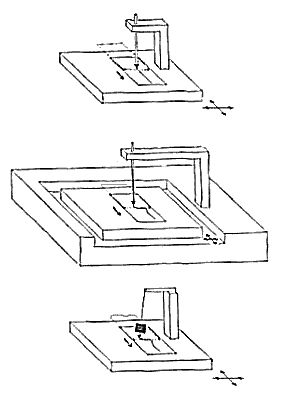3.1 Seismographs and Archimedes' point
A seismograph is conceived to record movements of the earth, which are caused by earthquakes. An observer who is himself situated on the ground moves with the quake and the ground. Because of this he cannot sense the absolute movement of the ground, as the ground does not move relative to the observer (fig. 27 upper section).
The observer should be at a point of absolute inertia not affected by the earthquake (fig. 27, central section). As such an Archimedes point is not available, it is simulated by a pendulum, the suspension of which is secured to the moving ground (fig. 27 lower section).
The movements of the ground incur the oscillation of the pendulum during which the pendulum, due to the inertia of its mass 'drags behind' the oscillation of the ground. During the moment of displacement the pendulum appears to move, whereas in fact it is nearly static and it is the ground itself which is moving.
If one now records the movement of the pendulum a picture of the earth's oscillations is created: a seismogram. The seismogram does not directly repeat the earth's oscillation but one can calculate this from the seismograph's readings. We shall return to this point again at a later stage (see chapter 5).
